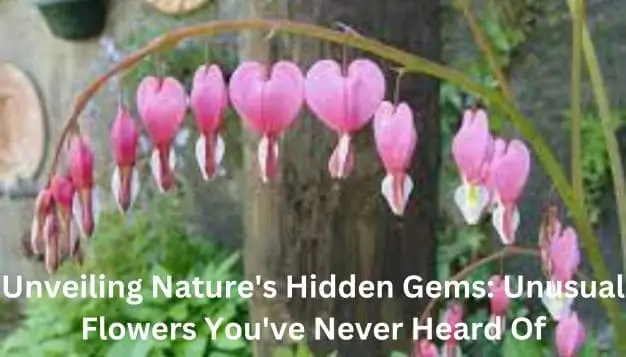In the vast and enchanting world of flora, a plethora of flowers captivates our senses with their vibrant colors, delicate fragrances, and unique shapes. While many of us are familiar with popular blooms like roses, lilies, and tulips, the botanical realm harbors a treasure trove of unusual and lesser-known flowers that are equally fascinating.
In this exploration, we will embark on a journey to discover some of nature’s hidden gems and unusual flowers that might have escaped your notice.
Bleeding Heart (Dicentra Spectabilis)
The Bleeding Heart, scientifically known as Dicentra Spectabilis, is a flower that elicits both curiosity and admiration. Native to Asia, this perennial plant earned its name due to its distinctively shaped blossoms resembling a heart with a droplet beneath, creating the illusion of a bleeding heart. The flowers dangle gracefully from arching stems, presenting a captivating and romantic appearance.
The flowers are usually bright fuchsia and hang down from arching stems. Bleeding heart is a spring-blooming flower native to Siberia, northern China, Korea and Japan. Even after the flowers fade away, the foliage provides elegant green leaves that fill shady garden spaces.
Corpse Flower (Amorphophallus Titanum)
Despite its ominous name, the Corpse Flower, or Amorphophallus Titanum, is a botanical marvel. Native to the rainforests of Sumatra, this colossal flower is renowned for its colossal size and pungent odor reminiscent of rotting flesh. The putrid scent serves a purpose – attracting carrion beetles and flies for pollination. The Corpse Flower’s rare and infrequent blooming makes it a spectacle, drawing crowds to botanical gardens when it occurs.
It gets its name from the pungent odor that it emits, like rotting flesh, which attracts beetles and insects for pollination. The corpse flower is the largest individual flower in the world, blooming only once every 7-10 years and reaching over 10 feet tall. When it finally does bloom, the deep maroon colored flower only lasts for a short time, making it highly prized by botanists and nature lovers.
Monkey Face Orchid (Dracula Simia)
Hailing from the cloud forests of Ecuador and Peru, the Monkey Face Orchid, scientifically named Dracula Simia, adds a whimsical touch to the orchid family. True to its name, the flower bears an uncanny resemblance to the face of a monkey, complete with a set of “ears.” This unusual appearance makes it a favorite among orchid enthusiasts and flower photographers seeking to capture the orchid’s unique charm.
The sepals and lateral petals form little caps that resemble monkey ears, while the lip appears like a monkey’s grinning face. These strange but charming flowers have an intricate maroon and green striped pattern. Found in the cloud forests of southeastern Peru and Ecuador, monkey orchids bloom from the Andean winter into spring.
Parrot Flower (Impatiens Psittacina)
Native to Southeast Asia, the Parrot Flower, or Impatiens Psittacina, is a species of balsam known for its vividly colored blooms that closely resemble a parrot in flight. The intricate design of the flower, coupled with its vibrant hues, makes it a rare and sought-after botanical wonder. The Parrot Flower’s unusual appearance serves as a reminder of nature’s creativity and diversity.
Dracula Orchid (Dracula Chimaera)
The Dracula Orchid, scientifically named Dracula Chimaera, is an orchid species found in the cloud forests of Ecuador and Peru. This unique orchid variety derives its name from the Latin word “dracula,” meaning “little dragon,” due to the eerie appearance of the flower’s long spurs resembling dragon fangs. The Dracula Orchid’s mysterious allure and intricate details make it a prized find for orchid enthusiasts and collectors.
Snapdragon (Antirrhinum)
While the Snapdragon (Antirrhinum) is not inherently uncommon, certain varieties possess a fascinating and unusual characteristic known as “snapdragon syndrome.” This genetic anomaly results in a flower that closely resembles a dragon’s face, complete with a gaping mouth that opens when squeezed. The Snapdragon’s unique trait adds a touch of whimsy to gardens and serves as a delightful conversation starter among horticulturists and flower enthusiasts.
While common in many gardens, the snapdragon has an unusual dragon-like appearance when fully opened. The name comes from the flower’s shape resembling the mouth of a dragon that opens and closes when squeezed. Snapdragons come in a rainbow of colors, with some varieties having two-tone or striped blooms. When fully opened, the snapdragon has three lobes with ruffled petals and a protruding lower lip like a dragon’s open mouth.
Chinese Lantern
The Chinese lantern plant, or Physalis alkekengi, has bright orange-red pods that resemble glowing lanterns. The plant is named for its use in Chinese festivals of light. After the small white and yellow flowers fade away, Chinese lanterns are left with vibrant seed pods enclosed in an inflated, paper-thin husk. Though they resemble flowers, the lanterns are actually berries. They are often preserved for dried flower arrangements.
Conclusion
In the world of flora, diversity knows no bounds. The unusual flowers highlighted in this exploration offer a glimpse into the extraordinary variety and ingenuity that nature has to offer. From the romantic allure of the Bleeding Heart to the bizarre beauty of the Corpse Flower, each bloom tells a story of adaptation, evolution, and the intricate dance between plants and pollinators.
As we continue to marvel at the well-known flowers adorning gardens and bouquets, let us not forget the hidden gems—nature’s unconventional masterpieces that inspire wonder and appreciation for the beauty that exists beyond the ordinary.

